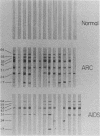Abstract
Serum samples from 27 patients infected with human T-cell lymphotropic virus type III (14 with acquired immune deficiency syndrome [AIDS] and 13 with AIDS-related complex) were examined for antibodies to viral proteins by the Western blot method and with four different commercial solid-phase enzyme-linked immunosorbent assays (ELISAs). Virus-specific bands on blots at molecular masses of 64, 55, 53, 41, 31, 24, and 17 kilodaltons were observed. Rank correlation matrices were calculated to relate the intensity of viral bands, stage of illness, and ELISA kit optical densities (ODs). Groups of bands tended to covary in intensity: p17, p24, and p55 (gag gene products); p53 and p64 (pol gene products); and p31 (pol/endonuclease gene product) and p41 (env gene product). Blots of sera from AIDS-related complex patients usually showed strong activity against all viral proteins, while those of sera from AIDS patients characteristically showed strong reactivity only at the pol/endonuclease and env bands. For one ELISA kit (Abbott Laboratories, North Chicago, Ill.), ODs correlated well with the env and pol band intensity scores, while ELISA ODs with other kits (from Litton Industries, Sunnyvale, Calif.; Electro-Nucleonics, Inc., Fairfield, N.J.; and E.I. du Pont de Nemours & Co., Inc., Wilmington, Del.) correlated closely with gag band intensity scores. We conclude that human T-cell lymphotropic virus type III Western blot patterns are determined by (i) viral protein processing pathways and (ii) the stage of illness of the patient and may reflect (iii) the ELISA method used for serum screening.
Full text
PDF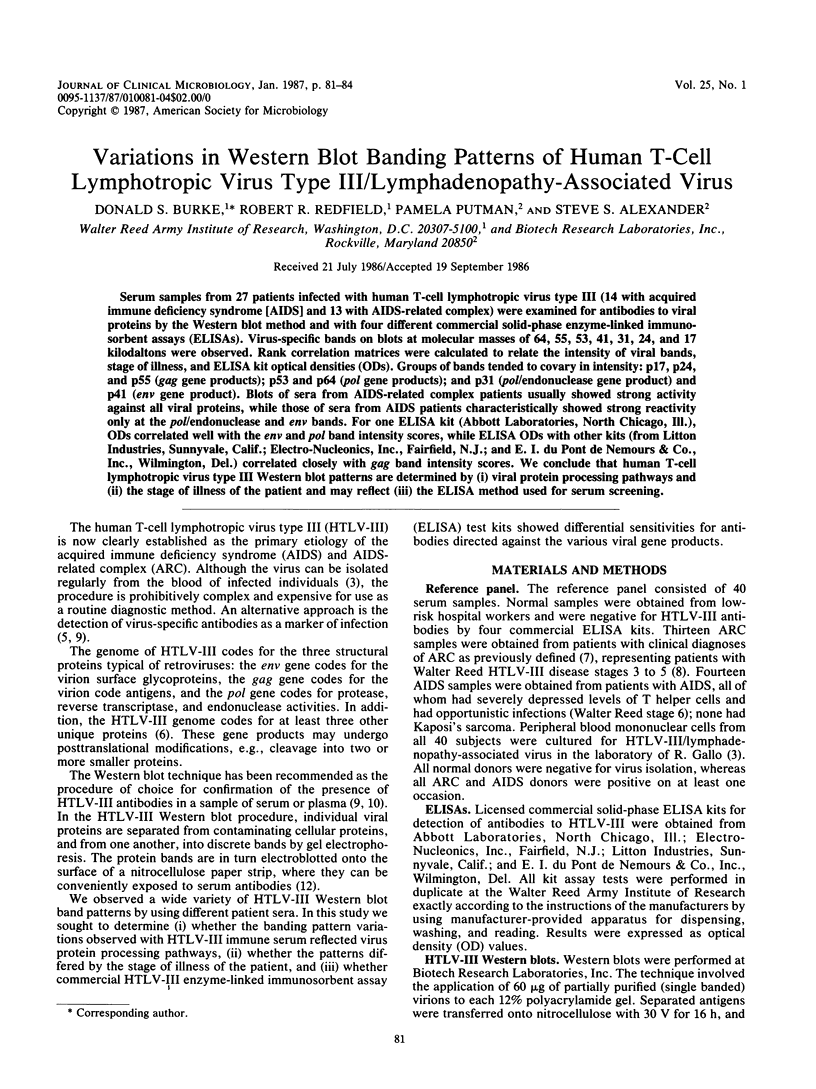
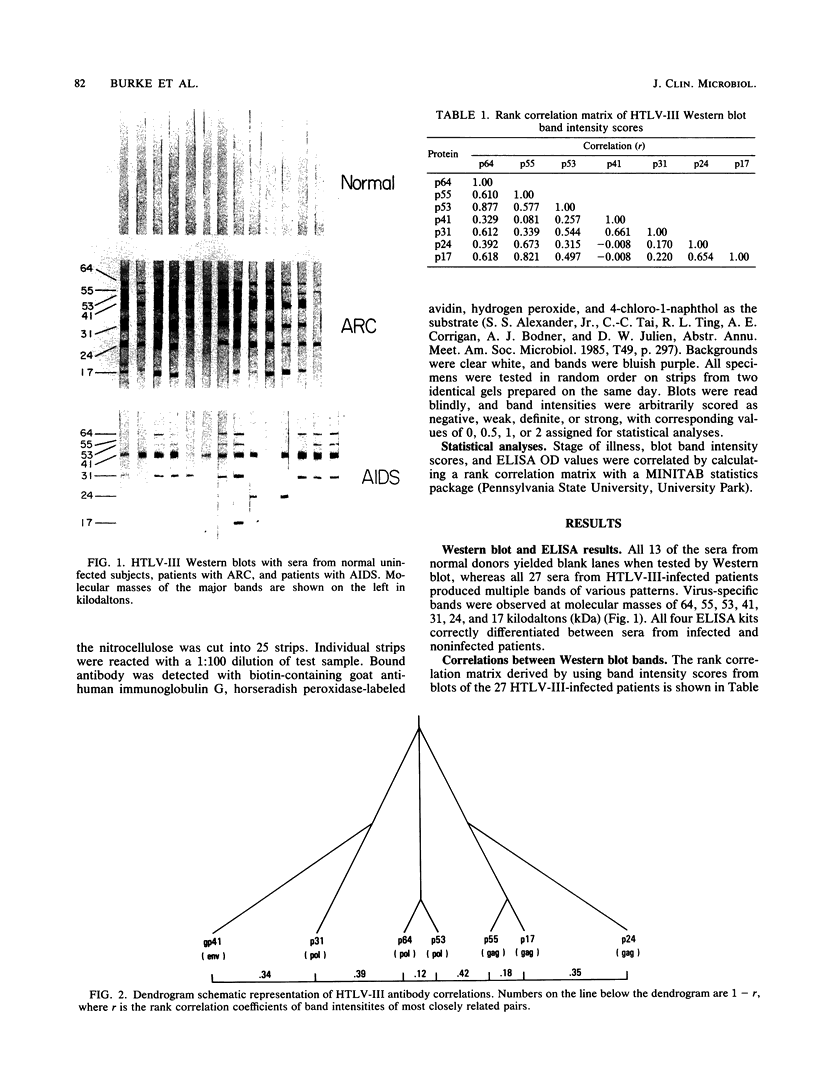
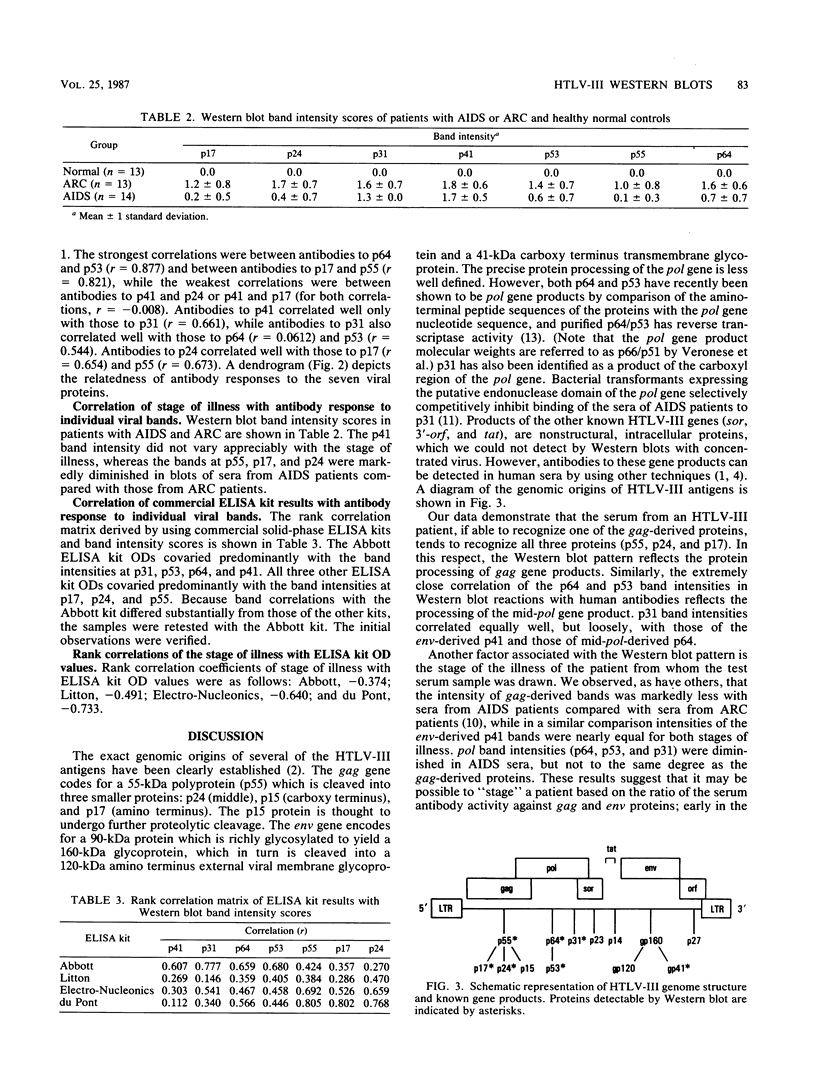
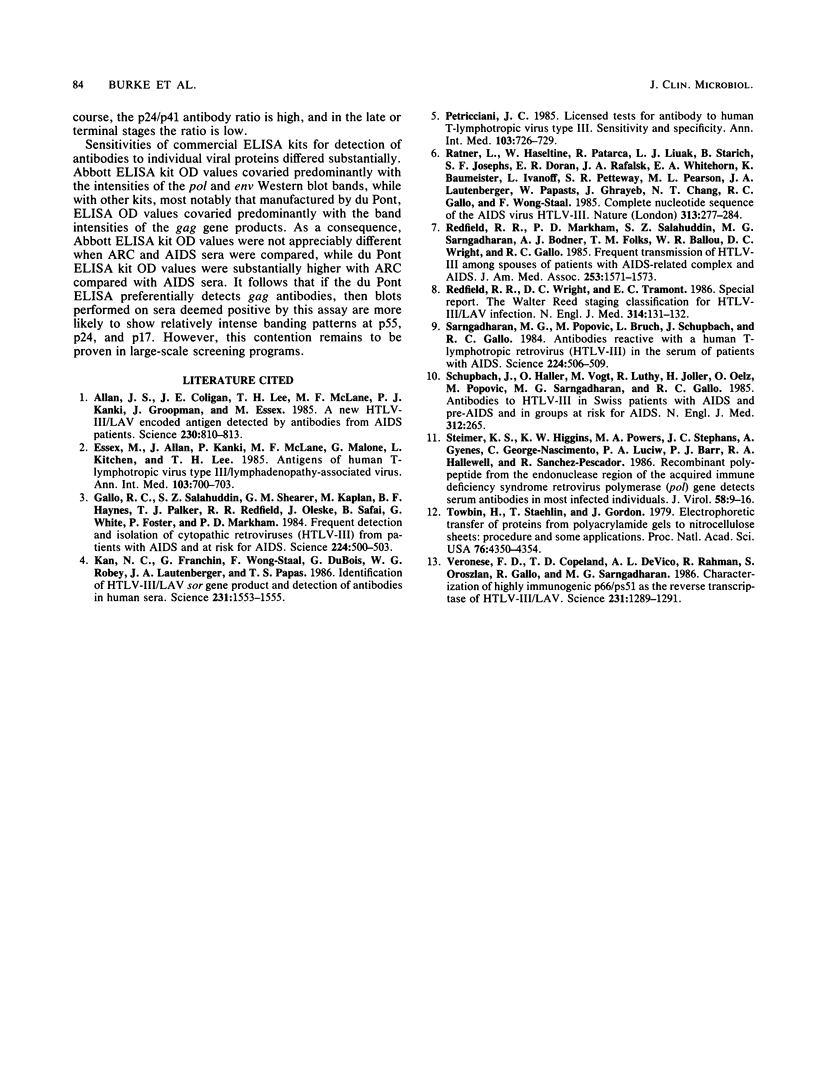
Images in this article
Selected References
These references are in PubMed. This may not be the complete list of references from this article.
- Allan J. S., Coligan J. E., Lee T. H., McLane M. F., Kanki P. J., Groopman J. E., Essex M. A new HTLV-III/LAV encoded antigen detected by antibodies from AIDS patients. Science. 1985 Nov 15;230(4727):810–813. doi: 10.1126/science.2997921. [DOI] [PubMed] [Google Scholar]
- Essex M., Allan J., Kanki P., McLane M. F., Malone G., Kitchen L., Lee T. H. Antigens of human T-lymphotropic virus type III/lymphadenopathy-associated virus. Ann Intern Med. 1985 Nov;103(5):700–703. doi: 10.7326/0003-4819-103-5-700. [DOI] [PubMed] [Google Scholar]
- Gallo R. C., Salahuddin S. Z., Popovic M., Shearer G. M., Kaplan M., Haynes B. F., Palker T. J., Redfield R., Oleske J., Safai B. Frequent detection and isolation of cytopathic retroviruses (HTLV-III) from patients with AIDS and at risk for AIDS. Science. 1984 May 4;224(4648):500–503. doi: 10.1126/science.6200936. [DOI] [PubMed] [Google Scholar]
- Kan N. C., Franchini G., Wong-Staal F., DuBois G. C., Robey W. G., Lautenberger J. A., Papas T. S. Identification of HTLV-III/LAV sor gene product and detection of antibodies in human sera. Science. 1986 Mar 28;231(4745):1553–1555. doi: 10.1126/science.3006245. [DOI] [PubMed] [Google Scholar]
- Petricciani J. C. Licensed tests for antibody to human T-lymphotropic virus type III. Sensitivity and specificity. Ann Intern Med. 1985 Nov;103(5):726–729. doi: 10.7326/0003-4819-103-5-726. [DOI] [PubMed] [Google Scholar]
- Ratner L., Haseltine W., Patarca R., Livak K. J., Starcich B., Josephs S. F., Doran E. R., Rafalski J. A., Whitehorn E. A., Baumeister K. Complete nucleotide sequence of the AIDS virus, HTLV-III. Nature. 1985 Jan 24;313(6000):277–284. doi: 10.1038/313277a0. [DOI] [PubMed] [Google Scholar]
- Redfield R. R., Markham P. D., Salahuddin S. Z., Sarngadharan M. G., Bodner A. J., Folks T. M., Ballou W. R., Wright D. C., Gallo R. C. Frequent transmission of HTLV-III among spouses of patients with AIDS-related complex and AIDS. JAMA. 1985 Mar 15;253(11):1571–1573. [PubMed] [Google Scholar]
- Redfield R. R., Wright D. C., Tramont E. C. The Walter Reed staging classification for HTLV-III/LAV infection. N Engl J Med. 1986 Jan 9;314(2):131–132. doi: 10.1056/NEJM198601093140232. [DOI] [PubMed] [Google Scholar]
- Sarngadharan M. G., Popovic M., Bruch L., Schüpbach J., Gallo R. C. Antibodies reactive with human T-lymphotropic retroviruses (HTLV-III) in the serum of patients with AIDS. Science. 1984 May 4;224(4648):506–508. doi: 10.1126/science.6324345. [DOI] [PubMed] [Google Scholar]
- Schüpbach J., Haller O., Vogt M., Lüthy R., Joller H., Oelz O., Popovic M., Sarngadharan M. G., Gallo R. C. Antibodies to HTLV-III in Swiss patients with AIDS and pre-AIDS and in groups at risk for AIDS. N Engl J Med. 1985 Jan 31;312(5):265–270. doi: 10.1056/NEJM198501313120502. [DOI] [PubMed] [Google Scholar]
- Steimer K. S., Higgins K. W., Powers M. A., Stephans J. C., Gyenes A., George-Nascimento C., Luciw P. A., Barr P. J., Hallewell R. A., Sanchez-Pescador R. Recombinant polypeptide from the endonuclease region of the acquired immune deficiency syndrome retrovirus polymerase (pol) gene detects serum antibodies in most infected individuals. J Virol. 1986 Apr;58(1):9–16. doi: 10.1128/jvi.58.1.9-16.1986. [DOI] [PMC free article] [PubMed] [Google Scholar]
- Towbin H., Staehelin T., Gordon J. Electrophoretic transfer of proteins from polyacrylamide gels to nitrocellulose sheets: procedure and some applications. Proc Natl Acad Sci U S A. 1979 Sep;76(9):4350–4354. doi: 10.1073/pnas.76.9.4350. [DOI] [PMC free article] [PubMed] [Google Scholar]
- di Marzo Veronese F., Copeland T. D., DeVico A. L., Rahman R., Oroszlan S., Gallo R. C., Sarngadharan M. G. Characterization of highly immunogenic p66/p51 as the reverse transcriptase of HTLV-III/LAV. Science. 1986 Mar 14;231(4743):1289–1291. doi: 10.1126/science.2418504. [DOI] [PubMed] [Google Scholar]



